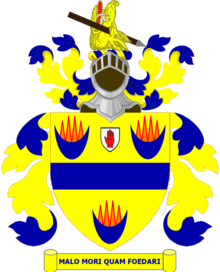|
Hutcheson Poë
Sir William Hutcheson Poë, 1st Baronet (20 September 1848 – 30 November 1934) was an Irish soldier and politician.[2] Early lifeHe was born the younger son of William T. Poë in Donaghadee, County Down.[3] His younger brother was Edmund Poë, who would become an Admiral in the Royal Navy.[4] An older brother, George Leslie Poë, became a Royal Navy Captain.[5] Military careerWilliam Poë joined the Royal Marines in 1867.[6] From 1878 to 1881 he commanded the Royal Marine detachment on Ascension Island. He served in the Mahdist War with the rank of major in 1884 and was wounded at the Second Battle of El Teb on February 29 1884.[7] He commanding a unit of the Egyptian Camel Corps in the Relief of Khartoum in 1885. However he was hit in the thigh by a bullet at the Battle of Metammeh on the 19th January, requiring the leg to be amputated[8][9] Subsequently he served in the Naval Intelligence Department and was prompted to lieutenant-colonel.[7] He retired from the Royal Marines in 1888.[10] Later careerAfter leaving military service, Poë settled in Ireland, living at Heywood House, Ballinakill. In Ireland, he owned 10,000 acres of land in County Tyrone and 1,500 acres in Queen's County.[7] He was a Justice of the Peace and Deputy Lieutenant for Queen's County and was appointed High Sheriff of Queen's County for 1891 and High Sheriff of Tyrone for 1893.[10] In the 1895 general election he stood as the Irish Unionist Alliance candidate for the Queen's County Ossory division,[7] but lost badly to the incumbent, Eugene Crean. He was a member of the Land Conference in 1902. In 1906, the Lord Lieutenant of Ireland made him a member of a commission to report on the state of Irish railways.[11] He was created a baronet on 2 July 1912. During World War I, he served in Egypt from 1915 to 1916; from 1916 to 1919 he served was with the Red Cross in France.[3] After the war, he was the Lord Lieutenant of Queen's County from 1920 to 1922. Following the Partition of Ireland, he was an independent member of Seanad Éireann from 1922 to 1924.[12] He was nominated to the Seanad by the President of the Executive Council in 1922 for 12 years.[13] He resigned from the Seanad on 9 December 1924, on age and health grounds.[14] Douglas Hyde was elected at a by-election to replace him. InterestsDuring his lifetime, Poë collected art. One of the works he owned, a portrait of John Musters by Sir Joshua Reynolds, is now in the collection of the United States National Gallery of Art[15][16] In 1904, Poë became a governor of the National Gallery of Ireland.[7] In 1931, he donated a 1690s painting by Jan Weenix to the gallery.[17] One of Poë's recreations was grouse shooting, though he was obliged to do this while seated on a pony due to the loss of his leg.[18] FamilyIn 1886 Poë married Mary Adelaide Domvile, only surviving daughter of Sir William Compton Domvile, 3rd Baronet. They had one daughter, Isabel-May (b. 1893), and one son, Hugo (1889–1959), who became the 2nd and last Baronet.[10] LegacyIn 1906, Poë commissioned Edwin Lutyens and Gertrude Jekyll to develop the gardens around his seat, Heywood House. The house was destroyed by fire in the 1950s, but the gardens still exist. They have been described as "one of the most beautiful formal gardens in Ireland".[19] See alsoReferences
External links
|
||||||||||||||||||||||||||||||||||||||||||

